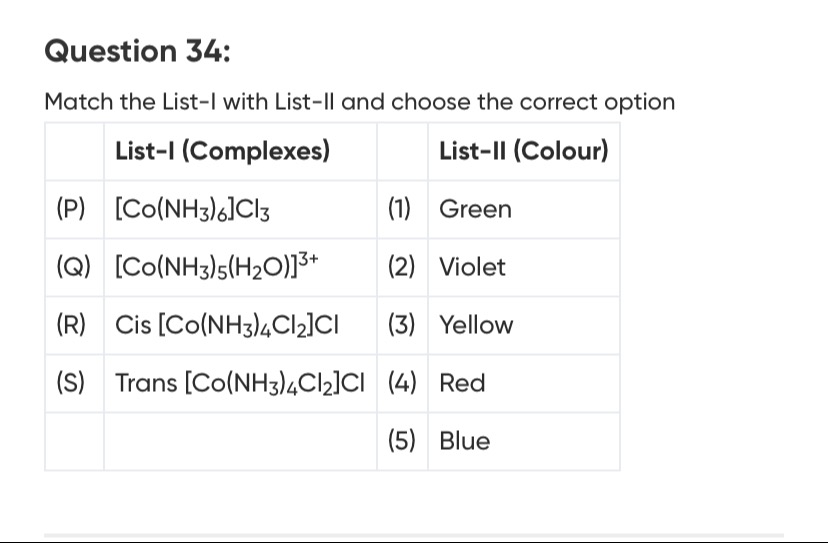Question
Question: Match the List-I with List-II and choose the correct option | | List-I (Complexes) | | List...
Match the List-I with List-II and choose the correct option
| List-I (Complexes) | List-II (Colour) | ||
|---|---|---|---|
| (P) | [Co(NH3)6]Cl3 | (1) | Green |
| (Q) | [Co(NH3)5(H2O)]3+ | (2) | Violet |
| (R) | Cis [Co(NH3)4Cl2]Cl | (3) | Yellow |
| (S) | Trans [Co(NH3)4Cl2]Cl | (4) | Red |
| (5) | Blue |

A
P-1, Q-2, R-3, S-4
B
P-3, Q-4, R-1, S-2
C
P-2, Q-1, R-4, S-3
D
P-4, Q-3, R-2, S-1
Answer
P-3, Q-4, R-1, S-2
Explanation
Solution
The colour of coordination complexes arises from d-d electronic transitions, which are dependent on the crystal field splitting energy (Δo). Δo is influenced by the nature of ligands (spectrochemical series) and the complex's geometry. The observed colour is complementary to the absorbed light.
Spectrochemical Series: Cl−<H2O<NH3 (Weak < Medium < Strong field ligands).
Complexes Analysis:
- (P) [Co(NH3)6]Cl3: Co3+ (d6) with six strong field NH3 ligands. This leads to a large Δo. The complex absorbs blue-green light and appears Yellow.
- (Q) [Co(NH3)5(H2O)]3+: Co3+ (d6) with five strong field NH3 and one medium field H2O. This results in a slightly smaller Δo than the hexammine complex. It absorbs green light and appears Red.
- (R) Cis [Co(NH3)4Cl2]Cl: Co3+ (d6) with four strong field NH3 and two weak field Cl− ligands in a cis arrangement. This results in a significantly smaller Δo. It absorbs red-orange light and appears Green.
- (S) Trans [Co(NH3)4Cl2]Cl: Co3+ (d6) with four strong field NH3 and two weak field Cl− ligands in a trans arrangement. This results in a smaller Δo than the cis isomer. It absorbs yellow-green light and appears Violet.
Matching:
- (P) → (3) Yellow
- (Q) → (4) Red
- (R) → (1) Green
- (S) → (2) Violet
